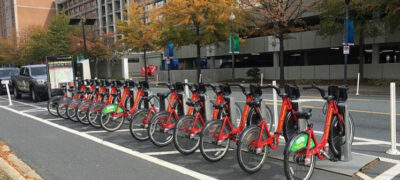There are now many ways in which transit agencies can deliver fare collection technology. In order to select the right fare system for the agency, an evaluation of the benefits and challenges of both the fare system and the associated fare payment types can be helpful in making a decision. Depending on the agency’s overall goals, factors such as capital and operating costs, access for all riders, validator, security, and data requirements may influence the final selection. The following tables address the potential benefits and challenges in implementing the fare systems, payments, and policies discussed in this guide.
| Fare System |
Benefits |
Challenges |
| Open Payment |
- Direct fare payment enables the transit agency to capitalize on the expertise of financial institutions and the payments industry
- Reduced queuing at stations
- Interoperability
- Ease of use for visitors or those not familiar with the system
- Reduced capital costs compared to contactless smart cards
- Potential to reduce transit provider’s role in processing fares
- Increased operational efficiency by eliminating the need to distribute cards
|
- Complex system requires additional security measures and systems in place to ensure valid payment methods
- Serving unbanked populations
- Real-time processing can be delayed
- Micropayments can result in higher transaction fees
- Additional equipment is needed to process the fares
|
| Account-Based Ticketing (ABT) |
- Passengers and transit agencies can easily view accounts and manage them remotely
- Fare capping and reduced fare compatible
- Simple management by transit agencies
- Enables for increased data collection and rider trends
|
- Requires back-end configuration
- Needs infrastructure on board the vehicle to allow for quick transactions such as Wi-Fi or a cellular network
- Delays or transaction outages may occur in areas without connection
- Additional IT management for security, risk management, and speed is required
|
| Fare Payment as a Service (FPaaS) |
- Cost-effective by utilizing one off the shelf, cloud-based platform
- Quick deployment of technology
- Technology upgrades are delivered regularly
- Mobility-as-a-Service enabled
- ABT enabled
- Transit agencies can select from vendors that best meet their needs
- Rider convenience and accessibility
- Security is managed by the cloud providers
- Vendors may provide IT customer service support
- Easy system maintenance and upgrades
|
- May require bus infrastructure such as Wifi or cellular network
- Firmware upgrades, often deployed to the hardware by the vendor automatically, may be buggy resulting in equipment outages
- Smaller network of vendors to choose from who may offer this type of service
- Transit agency RFP’s must explicitly outline requirements and needs from the vendor
|
| Fare Payments |
Benefits |
Challenges |
| EMV |
- Eliminates the need and costs for riders to obtain an additional card for transit
- Allows for riders to take advantage of fare capping if they utilize the same card for each transit trip
- The transaction is processed quickly via the financial institution
- Financial institution incurs any risks associated with the cost of the transaction
- Easily integrates with mobile wallets and other mobile devices, further increasing rider flexibility and convenience
- Reduces cost and administrative burden associated with reconciling cash payments
|
- Low-income riders and those below the age of 18 are more likely not to have access to a credit/debit card
- Fees for micropayments
- Additional equipment is needed to process the fares
- Requires rider to have a bank account that issues EMV compatible debit or credit cards
- Each rider is required to have their own card to use on board vehicles and cannot do multi taps per trip
- First-ride risk
- Difficult to implement fare capping and to setup reduced fares or special passes for eligible riders
|
| Smart Cards |
- The transit agency, 3rd party, authorized user, or the rider can easily view the account and manage the stored value on the card
- Riders are not required to have a smartphone, smart device, or bank account for physical smart cards
- Easily integrates fare capping
- Cards can be configured to allow for multiple taps/fare types, including family passes
- Can be reloaded at designated retail locations
- Increased protection of lost or stolen cards with card registration
|
- The cost to purchase the card is often passed onto riders
- Higher capital costs (fareboxes, readers, TVM, cards)
- Virtual smart cards require a smartphone
- Smart cards are required to be disbursed to riders by the transit agency
- Cards are more likely to be lost by passengers
- Not interoperable – card serves one purpose
- Creates waste – requires the manufacturing of plastic cards
|
| Mobile Ticketing |
- Easily configured to the transit agency’s existing fare structure
- Increased convenience for transit riders
- Reduced fares can be verified easily
- Can be white-labeled for the transit agency
- Tickets are in one central location
- Riders can store multiple tickets in their account
- Ability to integrate with trip planning phone apps
- It does not require the use of electronic fareboxes, ticket vending machines, or the manufacturing of physical cards
- No additional onboard equipment needed with visual validation = quicker to launch
|
- Requires a smartphone or smart device with power
- To purchase tickets, Wi-Fi or cell service is required
- The vendor often manages the platform, including any changes to the fare structure
- Additional customer service support may be needed for those who may not be tech-savvy
- Vendor transaction fees
- Non-US based smartphones or devices may not work/get service
- Not all people own a smartphone or smart device
|
| Fare Policy |
Benefits |
Challenges |
| Fare-Free |
- Eliminates cost barriers, improving access for all riders.
- Reduces administrative burden by removing the need for fare collection and reconciliation.
- Speeds up boarding, leading to improved operational efficiency.
- Prevents fare-related conflicts between drivers and passengers.
- Reduces reliance on fare collection technology and fareboxes.
|
- Requires alternative revenue sources to replace lost fare income.
- Funding must be secured long-term to maintain service levels.
- Agencies lose farebox data, requiring new methods to track ridership.
- May lead to increased demand, requiring adjustments in service levels.
|
| Cashless |
- Reduces costs and administrative effort associated with cash handling.
- Speeds up boarding and improves operational efficiency.
- Supports digital and mobile ticketing solutions for greater convenience.
- Encourages the adoption of more efficient, technology-driven fare systems.
|
- Serving unbanked populations
- Requires investment in additional technology
- Riders may need additional education on how to use new fare payment methods.
- Transitioning to cashless may cause short-term disruption for riders accustomed to paying with cash.
|
| Fare Capping |
- Increases equity by ensuring low-income riders do not pay more than wealthier riders who can afford passes upfront.
- Encourages ridership by offering automatic discounts over time.
- Reduces the need for upfront pass purchases, making transit more accessible.
|
- Requires a fare system that can track individual rider payments across trips.
- With some payment systems, riders must consistently use the same payment method or device to benefit from fare capping.
- May require updates to existing fare collection systems to support automatic tracking.
- Some riders may not understand how fare capping works, requiring education and outreach.
|

